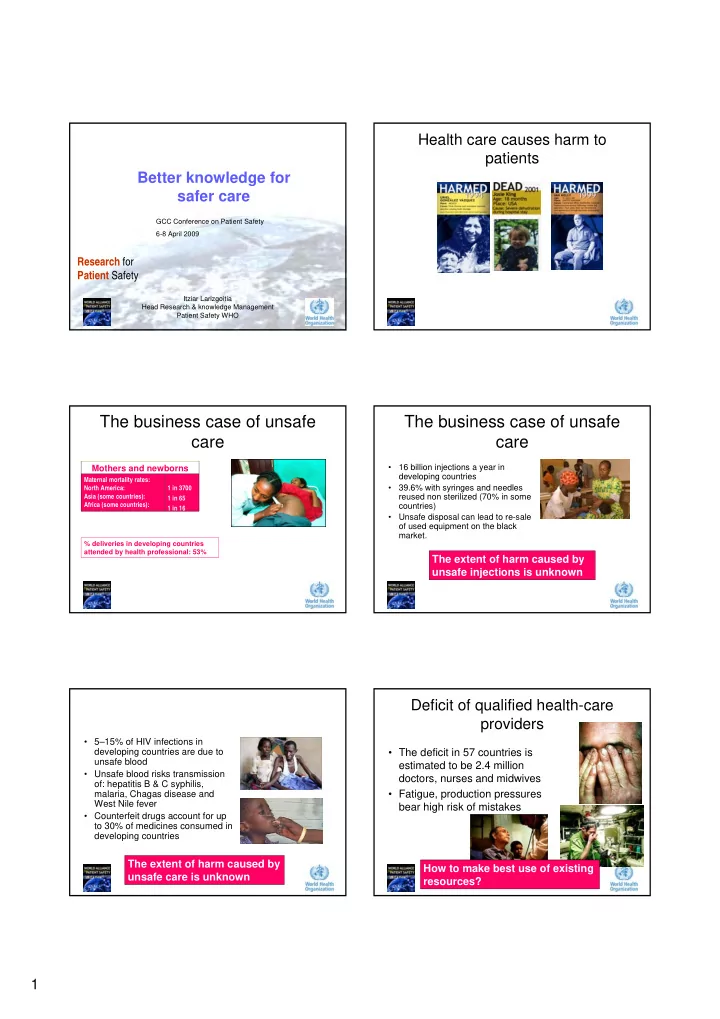

Health care causes harm to patients Better knowledge for safer care GCC Conference on Patient Safety 6-8 April 2009 Research for Patient Safety Itziar Larizgoitia Head Research & knowledge Management Patient Safety WHO The business case of unsafe The business case of unsafe care care • 16 billion injections a year in Mothers and newborns developing countries Maternal mortality rates: 1 in 3700 • 39.6% with syringes and needles North America: Asia (some countries): reused non sterilized (70% in some 1 in 65 Africa (some countries): countries) 1 in 16 • Unsafe disposal can lead to re-sale of used equipment on the black market. % deliveries in developing countries attended by health professional: 53% The extent of harm caused by unsafe injections is unknown Deficit of qualified health-care providers • 5–15% of HIV infections in developing countries are due to • The deficit in 57 countries is unsafe blood estimated to be 2.4 million • Unsafe blood risks transmission doctors, nurses and midwives of: hepatitis B & C syphilis, malaria, Chagas disease and • Fatigue, production pressures West Nile fever bear high risk of mistakes • Counterfeit drugs account for up to 30% of medicines consumed in developing countries The extent of harm caused by How to make best use of existing unsafe care is unknown resources? 1
The business case for unsafe Knowledge for patient safety care 5. Promoting • The problem of adverse events in health care is serious change 1. Measuring • The problem of adverse events in health care is more 4. harm serious in developing countries. But only scant data are Evaluating impact available 2. 3. Understanding Identifying causes solutions The WHO World Alliance for Collaborative model Patient Safety • Launched in October 2004 • Chair Sir Liam Donaldson, CMO England & Wales • To catalyze international action to promote safer care • Collaborative Model Systemic response to a systemic Measuring Harm problem • Estimating the global • Leading to identification of locally effective solutions burden of unsafe care • Focusing on cost-effectiveness of risk-reducing strategies • Focusing on local priority areas: – Counterfeit and substandard drugs – Lack of communication and coordination – Latent organizational failures – Inadequate competence, training and skills 2
Research gaps Small research grants (less than 33% of respondents) 1. Health care associated infections 2. Health services research • 500,000 USD/year to support 20-30 small 3. Safe medicines and devices < 30% 4. Quality improvement studies worldwide 5. Qualitative research • Targeting applied research to identify locally 6. Evidence based medicine effective solutions 7. Ethical issues in research • 21 Grants allocated in 2009 8. Understanding causes < 20% – Tunisia, Iran, Pakistan, 9. Blood and injection safety 10. Developing solutions – China, The Philippines, Vietnam 11. Patient involvement in research – Myanmar, New Zealand, Thailand 12. Evaluating impact – Chile, Peru, Venezuela, Brazil, Mexico 13. Economic evaluations • 14. Measuring harm 21 teams starting to develop research < 15% 15. Human factors / safety design projects in collaboration with WHO 16. Change management Research for Patient Safety is research Global resource needs to promote research and research training (n=109) for health systems with a focus on Funding of training 94% programs Funding patient harm More research funding 80% Global Training Gaps Training Demands Training for teachers 84% • Patient involvement in • Quality improvement "On the job" training to do Training research 62% • Safe medicines & devices research • Economic evaluations • Measuring harm More university courses 48% and degrees • Impact evaluations • Developing solutions More researchers to Human 51% mentor students • Developing solutions • Evaluating impact resources • Human factors/safety More teachers 46% • Understanding cause design Protected time for • Health services research 49% research Protected • Change management • Human factors/ safety time Protected time for 42% • Measuring harm teaching design 0% 10% 20% 30% 40% 50% 60% 70% 80% 90% 100% • Patient involvement in PSR Mainstreaming health systems to Catalyzing international avoid patient harm commitment • To mainstreaming patient safety in national • Focus research on the priority problems at health systems local level • To focus the importance of measurement to • Focus research to identify cost-effective understand the extent & nature of patient safety solutions at the local level • And to find locally cost-effective solutions to locally priority problems • Advance the business case for patient • To strengthening global and regional networking safety Only in this way we'll understand the extent and for patient safety improvement through nature of the problem measurement 3
www.who.int/patientsafety 4
Recommend
More recommend